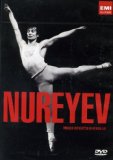 Nureyev | DVD | (24/11/2008)
from £12.84
| Saving you £-0.85 (N/A%)
| RRP
Nureyev | DVD | (24/11/2008)
from £12.84
| Saving you £-0.85 (N/A%)
| RRP No performer on the world stage received so much acclaim and publicity as Rudolf Nureyev and no one gave away so little about their private life and thinking. In this television biography made some twelve months before his death in 1993 Nureyev tells his own story in his own words and recalls turning points in his career. The programme traces Nureyev''s life starting out from his home town of Ufa in the shadow of the Ural Mountains half way between Moscow and Siberia. When filming took place there Ufa had changed very little since his departure thirty years before. The school was still there and so was the modest wooden house which his family shared with two others. The green curtains still hung at the old theatre where he saw the ballet performance which changed the course of his life. Nureyev''s sister his head mistress and the dance teacher who first discovered him (101 years old at the time this programme was made) all recall the solitary rebel. At the Kirov Theatre the prima ballerina who was his first partner remembers the student who emerged as the most brilliant dancer of his generation. The cameras were also allowed to film Nureyev on his Mediterranean island of Li Galli which once belonged to another Russian dancer Massine. Nureyev''s dancing career has been extensively chronicled on film and television. This definitive biography incorporates extensive archive material and documents Nureyev''s career with footage of his greatest roles and the most important events in his life
![Margot Fonteyn - A Portrait [1989]](/pictures/1028671.jpg) Margot Fonteyn - A Portrait | DVD | (20/04/2001)
from £24.99
| Saving you £-5.00 (N/A%)
| RRP
Margot Fonteyn - A Portrait | DVD | (20/04/2001)
from £24.99
| Saving you £-5.00 (N/A%)
| RRP Just two years before she died in 1991, Margot Fonteyn finally allowed a documentary to be made about her life and legendary career as the most romantic prima ballerina of all. Fortunately, the task fell to Patricia Foy. Together with her later appreciation of Rudolf Nureyev, this study offers an invaluable insight into the two dominant and most widely popular dancers of the 20th century. Fonteyn talks directly to camera, with disarming simplicity, about a professional career which endured for more than 40 remarkable years. Reminiscences of a childhood and youth in which she entertained ideas of being a tap dancer (it took Ninette de Valois to spot her unique talent) give way to archive footage of famous performances and interviews with key collaborators including Frederick Ashton and Robert Helpmann. Fascinating home movies give a brief glimpse of a hard-working but jet-set lifestyle which included sailing on Onassis' yacht with Maria Callas. But Fonteyn was that rarest of beings: a genuine celebrity who didn't appreciate her own authentic claim to greatness for many years. The understated way in which she discusses her marriage to Panamanian diplomat Roberto de Arias, her arrest and deportation during his unsuccessful attempt at a coup and later, the paralysing effect of a gunshot wound which would leave him a permanent invalid in her constant care, is deeply moving. Ultimately though, there is the dancing, and that partnership with Nureyev. Fonteyn was 42 when they first joined forces and she was anxious not to appear as "mutton dancing with lamb". How ironic. The erotic charge which they generated is still palpable in extended excerpts from Romeo and Juliet and Swan Lake. Essential viewing for balletomanes of every age. On the DVD: Apart from a trailer for other Arthaus releases, there are no special features. The mono sound does the musical extracts no favours, but it's the interviews that make this an archivist's treat. Well-produced, with the customary detailed booklet. --Piers Ford
![Nureyev - Rudolf Nureyev [1991]](/pictures/1032819.jpg) Nureyev - Rudolf Nureyev | DVD | (25/09/2000)
from £N/A
| Saving you £N/A (N/A%)
| RRP
Nureyev - Rudolf Nureyev | DVD | (25/09/2000)
from £N/A
| Saving you £N/A (N/A%)
| RRP Patricia Foy's absorbing Rudolf Nureyev--A Documentary, a portrait of surely the most committed and versatile dancer in the history of ballet, was made in 1991, two years before his death. It is as much the study of a life apart as a profile of a tireless jet-setting artist. His career took him from poverty-stricken provincial childhood to life as a student at the Kirov, through defection to the West in 1961 and on to the great classical roles on the world's most famous stages, a sublime professional partnership with Margot Fonteyn and a fascinating evolution as a supreme exponent of modern dance. And through it all, Foy's film suggests that for all Nureyev's desire to be a member of the corps, he always felt isolated. The dancer himself concludes by saying he never felt a part of society. This would be all too melancholy but for the rich cast of assembled contributors who shed light on his mercurial character and artistic intelligence, and the unexpected charm of a man often tagged "difficult" in the wretched tradition of show business cliché. Best of all, though, is the extended archive footage, which testifies to his extraordinarily athleticism and sheer grace. Never has the human form looked so fluid in motion. --Piers Ford

Please wait. Loading...
This site uses cookies.
More details in our privacy policy